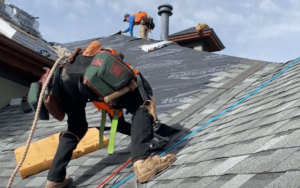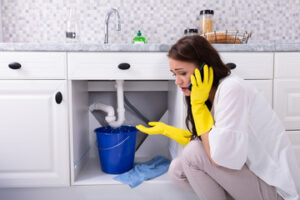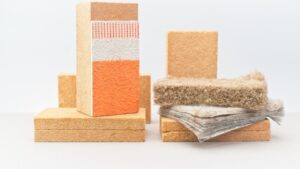The roof is the topmost part of a building. It protects the interior and exterior of the house from rain, snow, wind, and sunlight.
Choosing the right roofing material is important to ensure the roof’s long lifespan and performance. Many different types of roofs have been used in the past. For more information, click the Visit Our Website to proceed.

Waterproof
Roof waterproofing is a process of coating the roof surface with a special membrane to prevent leaks. This is a popular way to protect the structure of a building from water damage. This also helps to increase the lifespan of the roof. In addition, it reduces the risk of mold and mildew growth. This in turn, can help reduce the health problems of people living in the home or office.
Waterproofing can be done on a new construction or existing structure. Typically, it is done before any decoration or other work is carried out on the building. It is a quick and inexpensive way to protect the structure from leaks, which can be very costly.
Liquid applied waterproofing membranes are becoming more popular as a more sustainable alternative to traditional roofing materials. However, the success of these systems depends on the correct preparation and application of the substrate. In order to achieve long-lasting results, it is essential that contractors respect the manufacturer’s product limitations and apply the system according to its instructions. Many manufacturers offer specialized training for contractors, product knowledge meetings to distributors, and lunch & learn education sessions to architects and specifiers.
A popular choice of roof waterproofing is bitumen-based membranes, which are available in liquid and roll forms. These can be applied to the surface with a welding torch and have great adhesion and flexibility around uniquely-shaped roofs. Bitumen-based membranes are durable and are suitable for use on flat commercial and residential roofs.
In addition to being waterproof, a roof should also be able to reflect heat and UV radiation. This will keep the indoor temperatures in your house cool and comfortable. The combination of a reflective roof and a waterproofing product with UV protection can dramatically decrease your cooling costs.
Traditional sealers waterproof a material by locking the moisture inside, but this can be harmful to the material over time. This is because the trapped moisture will deteriorate the material, cause damage, and lead to the formation of mold and mildew. Instead, the best option is to use a waterproofing treatment with super hydrophobic properties. The ProPERLA SUPER HYDROPHOBIC technology is ideal for this, and the waterproofing products can be used on a variety of surfaces, including wood & paving.
Fireproof
When it comes to a home’s structure, the roof is its first line of defense against elements like sunlight, wind and precipitation. It also serves as a barrier against fires.
Whether you live in an area prone to wildfires or just want the added peace of mind that comes with knowing your house is protected from this natural threat, there are many options for fireproof roofing.
While no roofing material is 100% fireproof, some have a better rating than others. Roofing materials go through strenuous testing to determine their fire resistance. This includes assessing whether they’re non-combustible, can withstand severe fire exposure and don’t splinter or produce flying “firebrands”. They are then classified as Class A, B or C. Class A is the highest rating, and metal roofing is typically classified as this. Other options include clay tiles, slate and concrete tile.
In order to be rated as fire resistant, a roofing material must pass strict tests set forth by Underwriters Laboratories (UL) and the American Society for Testing and Materials (ASTM). When choosing a roofing material, make sure it’s marked with this certification. Those with a high fire rating will help protect your property from direct flames and hot embers that can fall through gaps in your roof.
There are also some roofing options that don’t necessarily add to a home’s aesthetic but are fire-resistant, such as concrete tiles. These are a great choice for those looking to replace a traditional asphalt shingle roof. These tiles are made of a durable, clay-based cement that’s baked in a kiln for a long time to ensure it has excellent fire resistance qualities. It is often marketed as terracotta roofing, and it’s available in a variety of colors and designs to suit any home.
Even if you don’t live in a wildfire-prone area, there is always the possibility that your neighborhood will be affected by a nearby wildfire or your chimney might catch fire from fireworks or a bonfire. In such cases, having a fire-resistant roof can keep your property safe and reduce the amount of damage done to other structures by fire.
Windproof
Strong winds are a natural part of our environment, but when they hit your home, they can cause serious damage. The force of wind can blow off shingles, and it can also carry debris that can damage the exterior of your home. This is why it’s important to invest in a roofing material that can resist high winds.
Choosing a wind-resistant roof can protect your home from severe damage caused by storms and other natural phenomena. It can also save you money in the long run, as it will decrease the need for costly repairs and replacements due to wind-related damage. Moreover, many insurance companies will consider the durability of a roof when providing coverage for your home.
One of the most effective ways to make your roof more resistant to high winds is by utilizing a roof shingle that has been engineered for this purpose. The shingle’s design must be compatible with your local weather conditions, and it should have adequate ventilation to minimize moisture accumulation.
The shape of your home and the type of roof can also influence its ability to resist high winds and hurricanes. According to a civil engineering professor at New Jersey Institute of Technology, some home shapes and roof designs are better suited for resisting wind forces than others. For example, a home with an octagonal or hexagonal floor plan is more likely to resist wind forces than a square or rectangular house. The pitch, or slope, of your roof can also be a factor. A steeper slope can provide greater resistance to uplift forces during a hurricane.
Another way to make your roof more resistant to high winds involves using proper installation techniques. The nailing pattern and the size of the nails used can impact your roof’s wind resistance. A reputable roofing contractor will use a nailing pattern that meets the manufacturer’s specifications, and they will ensure that the shingles are securely fastened to the sheathing and framing. They will also install metal drip edges along the eaves to reduce the leverage that wind can exert over your roof.
Wooden roofs are usually made of cedar, a durable and strong natural material. Cedar is naturally resistant to insect infestation and rotting, making it one of the most sustainable roofing materials available. Wood shakes and shingles typically last 15 to 30 years before needing replacement.
Although they’re one of the most environmentally friendly roofing options, wood shingles and shakes require more maintenance than other types of roofs. They must be regularly treated with preservatives and protective coatings to prevent rot and mold growth.
When selecting a wood shake or shingle, you’ll want to choose the type that suits your preferences and budget. Wood shingles and shakes come in two varieties: Shakes are thicker and feature a rugged appearance. They’re split by hand, allowing each piece to have a unique grain pattern and ridges that give your home an organic look.
They’re a popular choice for cabins and rustic-style homes, but can be used on any roof. They’re also less expensive than other types of shingles, but they may not be suitable for homes in areas that experience a lot of rain or wildfires.








